Fighters, Be Ambitious!
Smack!
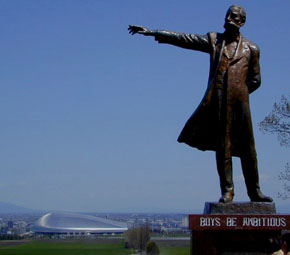 I leaned over and stared back through my office doorway from the newsroom hallway. With another ball balanced in the center of my palm, I wound up and delivered.
I leaned over and stared back through my office doorway from the newsroom hallway. With another ball balanced in the center of my palm, I wound up and delivered.
Smack! The stack of phonebooks, resting on a chair firmly planted against the back wall, absorbed the blow. I straightened back up and reached for another from the bag. Okay, now a curve.
Smack! I wiped my brow.
"Are you going through this charade again?" said a familiar voice. Junior reporter Junko walked up; high on energy, short on skirt - the wonders of the workplace in summer.
"What is it this time?" she asked. "You saw The Rookie and got inspired, didn't you? A beaten down old man can do anything if he puts his mind to it, right?"
Smack!
"Well, why not try something new? Why not get inspired into being a responsible reporter instead of an alcoholic who celebrates the arrival of massage parlor coupons in the mail?"
Smack!
"You know, that fastball of yours couldn't crack a pane of glass. And your change-up isn't enough to fool a fourth grader."
Smack!
"But now that I think about it, the Fighters could sure use some help in middle relief, even a shoddy arm. Get yourself a jacket though, they are headed to Sapporo in two years."
She tossed a report down at my feet, spun on her high heels, and moved in the direction of her desk.
Smack!
The right hand of William S. Clark's bronze statue points off into the hazy distance from atop the bluff at Hitsujigaoka, an open area of rolling green outside Sapporo. At the statue's base is a marker holding the doctor's signature phrase: "Boys, be ambitious."
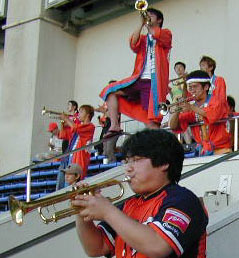 The doctor was an American professor who established the Agriculture College of Hokkaido in the late nineteenth century. This phrase, uttered to his students as he departed Japan, has subsequently been used over the years to inspire Japanese in times of hardship and need.
The doctor was an American professor who established the Agriculture College of Hokkaido in the late nineteenth century. This phrase, uttered to his students as he departed Japan, has subsequently been used over the years to inspire Japanese in times of hardship and need.
Little did he know that a baseball team would one day take his advice.
The Nippon Ham Fighters, a team seemingly always in some kind of need - usually pitching - will make an ambitious move in the 2004 season and leave Tokyo for Sapporo and the one-year old Sapporo Dome.
Success in this endeavor for the Fighters will take more than simply abandoning their shared use of the Tokyo Dome with the Yomiuri Giants and leaving the congested Tokyo market of six current franchises. The suffocating iron fist of the extremely popular Giants exists everywhere, even the icy environs of Hokkaido. The key for them will be putting a winning team on the field in an accommodating baseball environment that will generate a large fan support. Whether they will sink, swim, or fight on is not clear now. Though their few, yet highly devoted, fans have some tips for their team.
In the left field stands of Chiba Marine Stadium during a contest between the Chiba Lotte Marines and the Fighters on a recent Sunday sits Kazuya Tejima. Actually he is standing, and cheering for his favorite player, outfielder Tsutomu Ishimoto, to smack the ball (Katobase Ishimoto!) A cardboard poster with Ishimoto's name in black pen is in his hands. To his right is the main section of the Fighters' oendan, or cheering section. Horns, drums, whistles accompany the handful of uniformed cheerleaders, back to the action, leading the chants of the faithful near the outfield fence.
After Ishimoto is retired, Tejima explains his reservations about the move: "Everywhere there are Giants fans. Most people know [Sadaharu] Oh and [Shigeo] Nagashima. Even though Nagashima has retired, the media still makes a big star out of him so [success] will be difficult. Nobody will care about the Fighters. The Hokkaido image is that of the Giants."
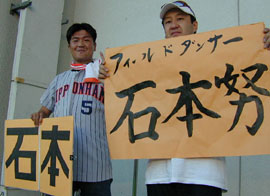 The fans of Sapporo are going to have to perhaps learn to embrace a different game as well if they are to adopt the Fighters, or so says 36-year old Kazushige Funyu, seated near Tejima. "Hokkaido is known for winter sports, skiing and ice skating," he says. "When the Fighters move, I hope that Sapporo people will learn to love baseball."
The fans of Sapporo are going to have to perhaps learn to embrace a different game as well if they are to adopt the Fighters, or so says 36-year old Kazushige Funyu, seated near Tejima. "Hokkaido is known for winter sports, skiing and ice skating," he says. "When the Fighters move, I hope that Sapporo people will learn to love baseball."
Image of the ball club, too, is important and the beef scandal that has harmed Nippon Ham's reputation over recent months will not help.
The scandal resulted when Nippon Meat Packers (Nippon Ham) altered labels of some foreign beef products to indicate domestic origin to claim government subsidies paid out in a beef-buy-back program that was intended to help the meat industry after it suffered from the outbreak of mad cow disease. As a result, the scandal has caused retailers to take many Nippon Ham products from their shops.
"Look at what happened to Snow Brand Milk," says Tejima of the continuing fallout of the food poisoning scandal that rocked Japan's largest dairy company 2 years ago. "The Fighters must first overcome the [beef scandal]. It is a huge problem."
In thinking of the outcomes for such a large undertaking, what effect will the move - the first for a Japanese club since the Lotte Orions moved from Kawasaki to Chiba ten years ago - have on the Japanese game?
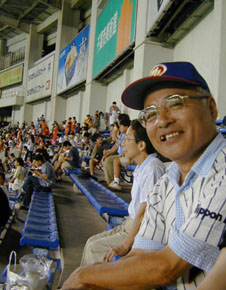 With Japanese baseball's popularity in need of a boost from the recent departure of some notable players to North America, could this move northward be the beginning of a national boom in the sport similar to which took place after the Brooklyn Dodgers abandoned New York for the sunny skies of Los Angeles fifty years ago?
With Japanese baseball's popularity in need of a boost from the recent departure of some notable players to North America, could this move northward be the beginning of a national boom in the sport similar to which took place after the Brooklyn Dodgers abandoned New York for the sunny skies of Los Angeles fifty years ago?
Likely not. These are the Fighters, a team that is generally unloved and hasn't won a pennant since 1981; and this is Japanese baseball, a league that would allow rapid changes in the game as easily as the Japanese government would encourage bank loan reform.
Rather, the move will be more for the sole benefit of the Fighters with management probably hoping to replicate the success of the Fukuoka Daiei Hawks, a team that has slowly built up a sizeable fan base after moving south from the Kansai area for Japan's island of Kyushu a little over a decade ago.
Fighters' fans are not convinced that it will work.
"During the first year, there will be some excitement," explains Minegi Yamamoto, "but after that the novelty will wear off."
Yamamoto, who attends 80 games a year, says that there are too many things wrong with the Japanese game for any one team, outside of the Giants and a few others, to develop strong, consistent support. His biggest gripes include high ticket, food, and souvenir prices at the games and the lack of effective and efficient transportation for families to get to the ballparks.
"I want more aggressive play," Yamamoto says, pointing out to the field, his 8-year old Fighters hat planted on this 66-year old head. "These players are given too much money from the start." Yamamoto believes that large sums of money up-front to young players results in unmotivated play on the field.
Stadium atmosphere in Japan is also lacking, or so argues Tejima. "Tokyo Dome is a boring place to watch a game," he says. This in spite of the fact that the Dome features Fighty, the bicycle riding bird mascot of the Fighters. "I like the open air here at Chiba Marine."
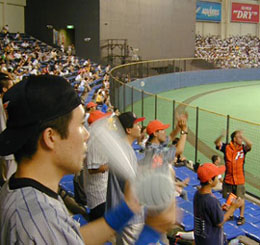 But the Fighters have been making strides in recent years, going above and beyond Fighty's antics, to attract fans; they dropped their loud yellow and orange uniforms of the '80s for classy pinstripes; they began offering a season pass in the 2001 season whereby fans can watch all home games for the reasonable amount of 19,000 yen; and they have been competitive in recent years, including second-place finishes in 1996 and 1998 that featured powerful offensive lineups.
But the Fighters have been making strides in recent years, going above and beyond Fighty's antics, to attract fans; they dropped their loud yellow and orange uniforms of the '80s for classy pinstripes; they began offering a season pass in the 2001 season whereby fans can watch all home games for the reasonable amount of 19,000 yen; and they have been competitive in recent years, including second-place finishes in 1996 and 1998 that featured powerful offensive lineups.
Baseball will not be a complete novelty to Sapporo by the time the Fighters arrive. Just last year the shiny silver-roofed $300 million Sapporo Dome, situated just a little more than a Sherman Obando home run shot across a green farmer's field from the Doctor Clark's current lofty perch, featured 15 contests. The games involving the Giants were all sell outs while games played between the Pacific League's Lions and Marines averaged a respectable 32,000 in attendance.
But after the Fighters unpack the moving trucks and start taking infield practice in preparation for the 2004 season, perhaps the most important issue of all will concern whether these fans will remain Fighters' fans.
"Of course!" exclaims Funyu. "I keep the dream that one day they will win the championship."
Give it your best, boys, the doctor will be watching.
Note: Yumi Hara contributed to this report.

